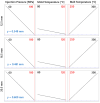Study of Injection Molding Process to Improve Geometrical Quality of Thick-Walled Polycarbonate Optical Lenses by Reducing Sink Marks
- PMID: 39204539
- PMCID: PMC11360770
- DOI: 10.3390/polym16162318
Study of Injection Molding Process to Improve Geometrical Quality of Thick-Walled Polycarbonate Optical Lenses by Reducing Sink Marks
Abstract
This study investigates the challenges and potential of conventional injection molding for producing thick-walled optical components. The research primarily focuses on optimizing process parameters and mold design to enhance product quality. The methods include software simulations and experimental validation using polycarbonate test samples (optical lenses). Significant parameters such as melt temperature, mold temperature, injection pressure, and packing pressure were varied to assess their impact on geometric accuracy and visual properties. The results show that lower melt temperatures and higher mold temperatures significantly reduce the occurrence of dimensional defects. Additionally, the design of the gate system was found to be crucial in minimizing defects and ensuring uniform material flow. Effective packing pressure was essential in reducing volumetric shrinkage and sink marks. Furthermore, we monitored the deviation between the predicted and actual defects relative to the thickness of the sample wall. After optimization, the occurrence of obvious defects was eliminated across all sample thicknesses (lenses), and the impact of the critical defect, the sink mark on the planar side of the lens, was minimized. These findings demonstrate the substantial potential of conventional injection molding to produce high-quality thick-walled parts when these parameters are precisely controlled. This study provides valuable insights for the efficient design and manufacturing of optical components, addressing the growing demand for high-performance thick-walled plastic products.
Keywords: injection molding; optical lenses; polycarbonate; process evaluation; quality improvement; thick-walled parts.
Conflict of interest statement
The authors declare no conflicts of interest.
Figures
































References
-
- Thick-Walled Lenses: Efficient Production. [(accessed on 28 March 2023)]. Available online: https://en.kunststoffe.de/a/specialistarticle/thick-walled-lenses-effici....
-
- Hopmann C., Robig M. Application of a multilayer injection molding process for thick-walled optical components. J. Polym. Eng. 2016;36:557–562. doi: 10.1515/polyeng-2014-0259. - DOI
-
- Nian S., Zhao X., Jiang Z., Xu Y., Yang Y. Multilayer injection molding of high-profile convex lens. J. Appl. Polym. Sci. 2020;137:e48600. doi: 10.1002/app.48600. - DOI
-
- Liemann S., Schneider J., Reger K., Niendorf T., Ahorn M., Luger S. Reducing Production Cycle Times of Thick Lenses by Applying Simulation and Multi-Layer Technology; Proceedings of the 4th International LED Professional Symposium + Expo; Bregenz, Austria. 30 September–2 October 2014.
-
- Wang M.W., Liu J., Li H., Wang X. Modeling and Analysis of Multi-Shot Injection Molding of Blu-Ray Objective Lens. J. Mech. Sci. Technol. 2018;32:4839–4849. doi: 10.1007/s12206-018-0932-z. - DOI
LinkOut - more resources
Full Text Sources

